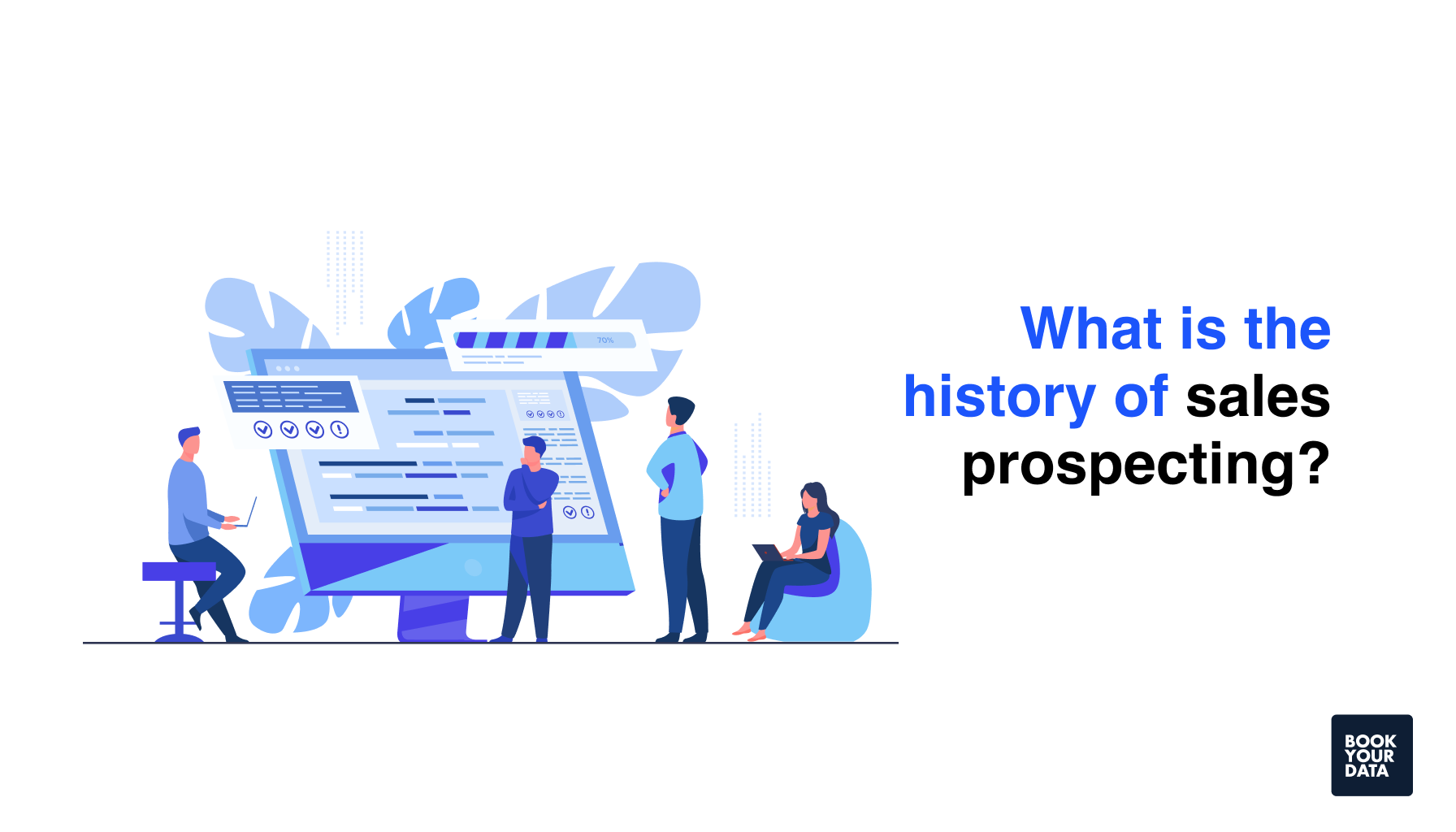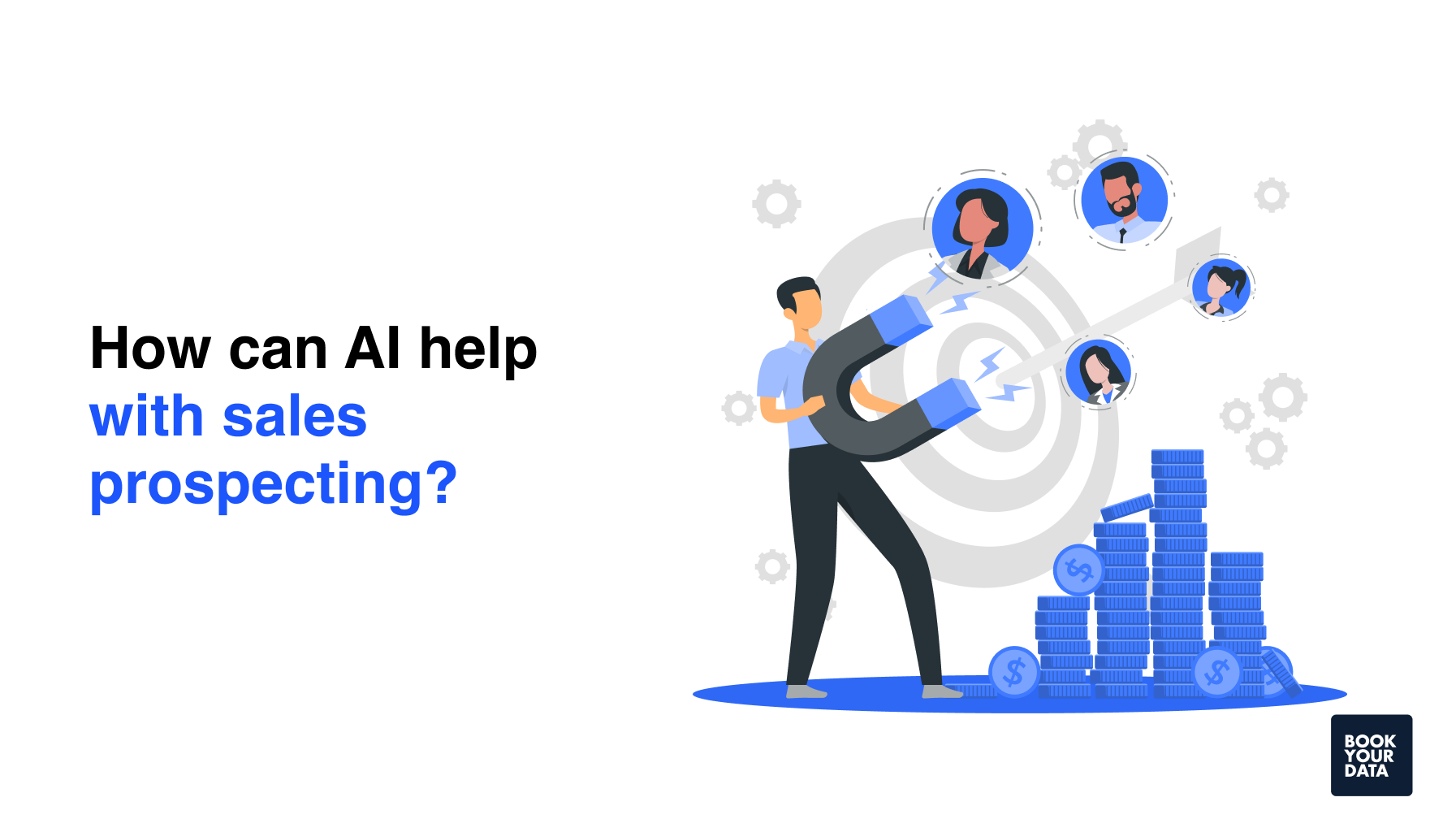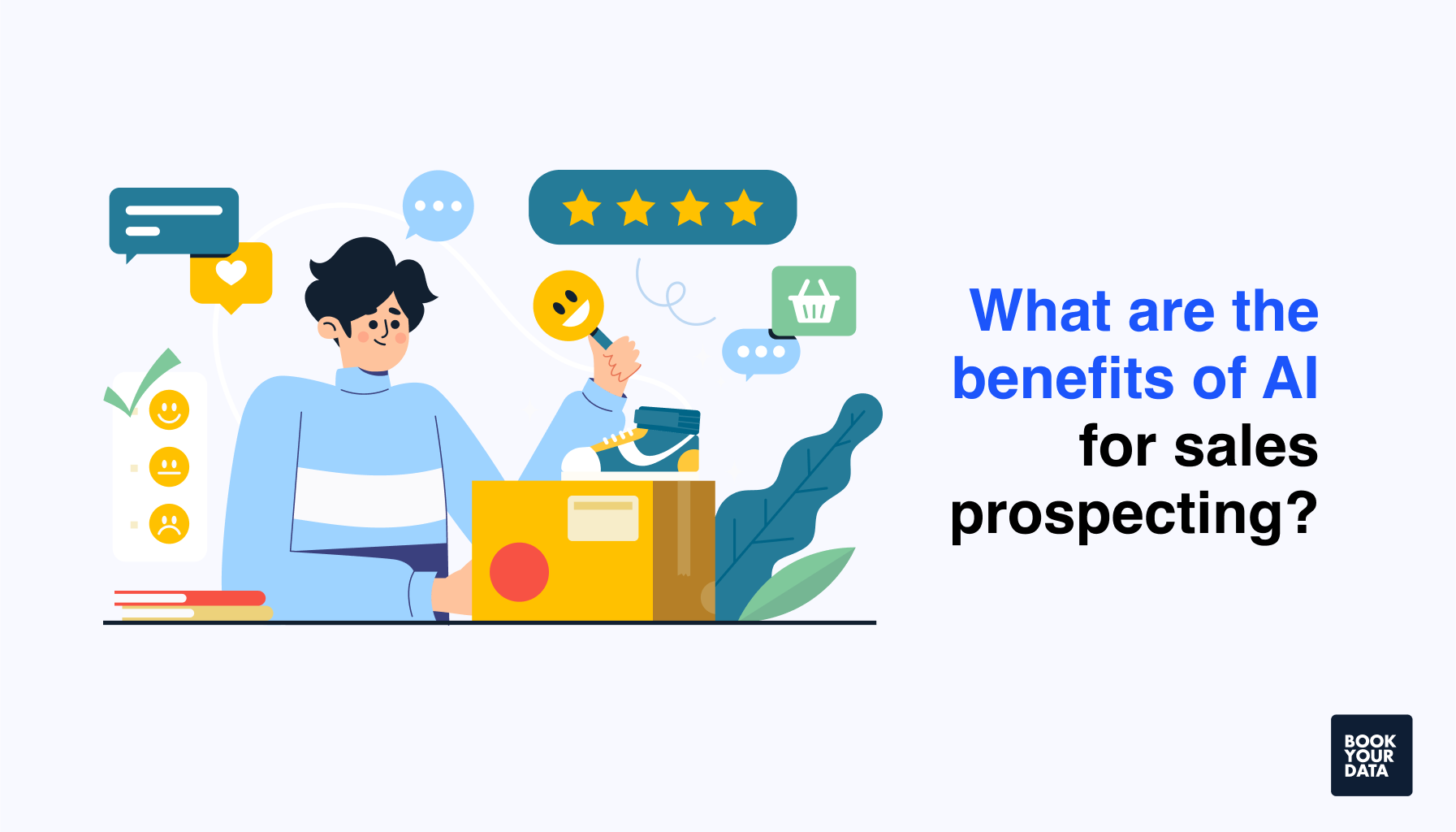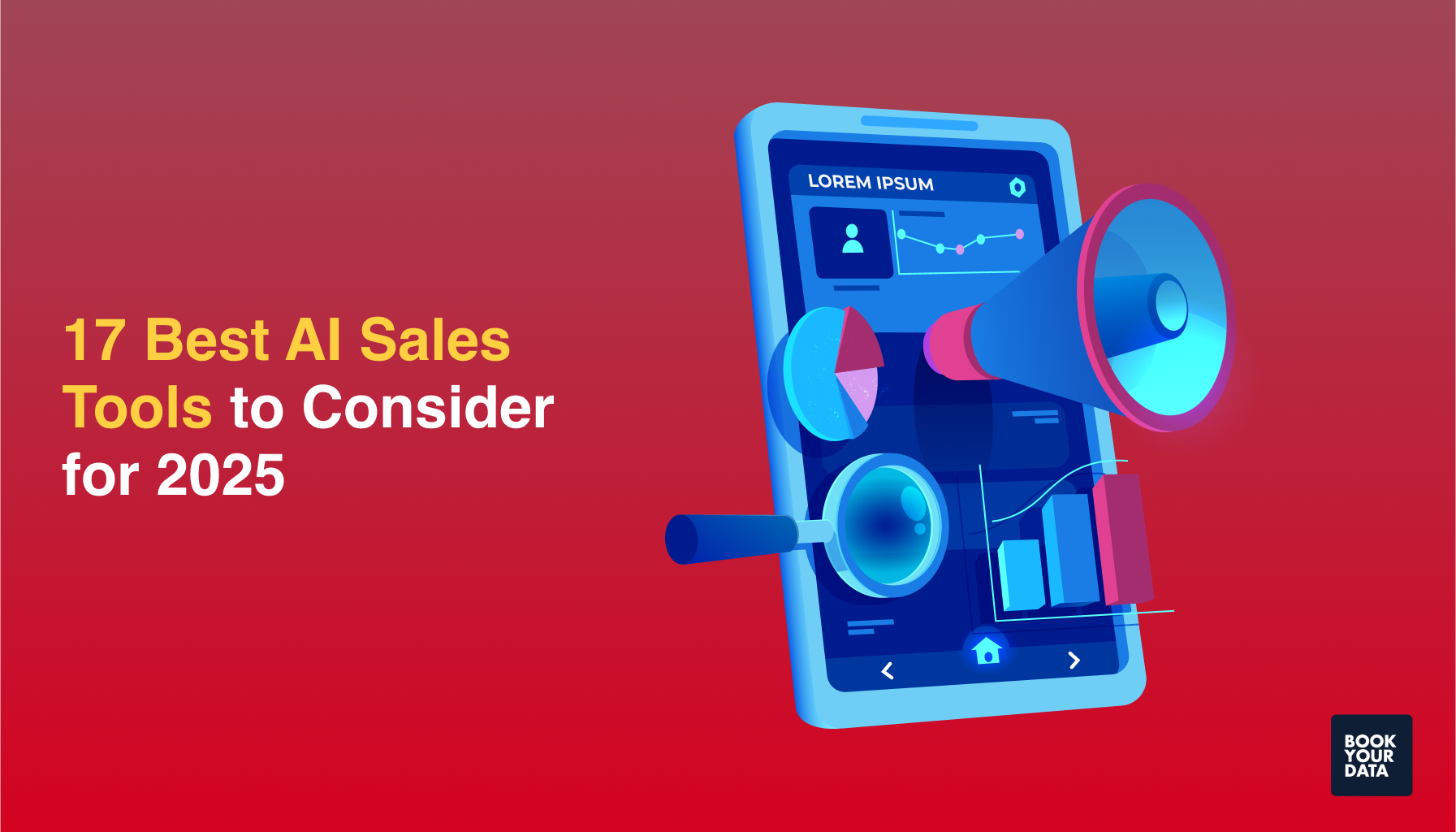AI for Sales Prospecting: Definition, Features, Benefits, and Best Practices
AI for sales prospecting is the use of artificial intelligence tools to automate and improve the way businesses find, qualify, and connect with potential customers. People consider traditional and manual prospecting methods, like cold calling and spreadsheets, to be too slow in today’s digital world. AI reduces repetitive tasks, automates customer interactions, and helps sales teams focus on closing deals.
Technologies like machine learning, natural language processing (NLP), and predictive analytics work behind the scenes to analyze data sets, spot trends, and personalize outreach. AI can identify high-potential leads faster, suggest the best time to engage, and even improve productivity by offering strategic insights. As a result, businesses see better conversion rates, stronger engagement, and increased lead generation. All these factors lead to an improved financial performance.
In this blog, we’ll break down everything you need to know about AI for sales prospecting, including its features, benefits, top use cases, and best practices to help your sales team thrive.
What is AI for sales prospecting?

AI for sales prospecting means using artificial intelligence to help businesses find and connect with the right customers faster and smarter. AI sales prospecting isn’t just helpful but necessary in today’s competitive market. It works by automating repetitive tasks like analyzing customer data, identifying leads, drafting emails, and giving insights about which leads can convert into potential customers. This makes outbound prospecting easier, so sales teams can focus more on building real connections instead of spending hours digging through spreadsheets.
AI also helps B2B sales professionals spot intent signals like a person browsing specific pages or engaging with content, which helps qualify leads better. Teams can engage with prospects more effectively and at the right time by automating the early stages of the sales process.
What is the history of sales prospecting?

The history of sales prospecting started when it mostly meant cold calling from phone books or using printed company directories. However, these methods were slow and unproductive. Salespeople had little to no access to customer behavior data back then, making it hard to know who was actually interested.
Things started to shift in the 1990s with the rise of early CRM systems. These tools made it easier to store and manage customer information, turning prospecting into a more research-based process. Later, automation, machine learning, and data analytics began to play a bigger role, cutting down on manual work like data entry and follow-ups. Tools like email templates and basic chatbots also became common for outreach and customer support.
Fast forward to 2023 - 2024, the post-ChatGPT era, and generative AI has taken the spotlight. Sales and marketing teams are using AI to write personalized emails, prioritize leads, and even talk to prospects using smart chatbots.
How can AI help with sales prospecting?

AI helps with sales prospecting by automating lead identification, personalizing outreach, automating task completion, improving sales workflow, using predictive analytics, scoring leads automatically, and using chatbots for instant response.
Let’s study these key points in detail below.
- Automating lead identification: AI scans through huge amounts of online data, from social media activity to website behavior. It spots people or companies who might be interested in your product. This saves hours of manual research and brings in better quality leads from the start.
- Personalizing outreach: AI tools can create personalized emails and messages for each lead instead of sending the same message to everyone. It looks at the lead’s job role, industry, and past interactions to make the message feel more relevant and human.
- Automating task completion: AI can take care of routine tasks like scheduling emails, logging calls, updating contact details in the CRM, or even setting up meetings. This frees up salespeople to focus more on building real relationships and closing deals.
- Improving sales workflow: AI helps organize the daily workflow by suggesting which tasks to prioritize based on urgency and lead behavior. This means representatives can work more efficiently and avoid missing out on hot opportunities.
- Using predictive analytics: AI uses past sales data to predict which leads are most likely to convert. This helps teams spend more time on leads that have a higher chance of becoming customers, increasing success rates.
- Scoring leads automatically: AI assigns scores to leads based on their engagement, profile, and behavior. A high score means a lead is ready to be contacted, so sales reps can act quickly without second-guessing.
- Using chatbots for instant response: AI-powered chatbots can answer common questions, collect lead information, and even schedule demos 24/7. This means no missed opportunities, even when your team is offline.
What are the benefits of AI for sales prospecting?

The benefits of AI for sales prospecting include saving time on repetitive tasks, improving lead quality, boosting personalization, increasing conversion rates, reducing human error, and scaling sales efforts.
Let’s explore these benefits in detail below.
- Saving time on repetitive tasks: AI handles time-consuming tasks like sorting leads, sending follow-ups, and updating CRMs automatically. This gives sales teams more time to focus on talking to real prospects and closing deals.
- Improving lead quality: AI tools analyze data to find leads that actually match your ideal customer profile. Instead of wasting time on unqualified prospects, your team can focus on the ones most likely to convert instead of wasting time on unqualified prospects.
- Boosting personalization: AI helps personalize messages for each prospect by using details like job role, industry, and past behavior. Personalized outreach feels more genuine and usually gets better responses.
- Increasing conversion rates: AI naturally improves the chances of turning prospects into customers with better leads and more relevant outreach. Sales teams can close more deals with less effort.
- Reducing human error: Manual data entry often leads to mistakes, but AI handles data more accurately. This means fewer mix-ups and mistakes, and better decisions based on reliable information.
- Scaling sales efforts: AI allows businesses to reach more prospects without hiring a bigger team. From automated emails to smart chatbots, AI supports growth without extra stress.
What are the disadvantages of AI for sales prospecting?
The disadvantages of AI for sales prospecting include a lack of human touch, dependence on quality data, and privacy and compliance risks.
These disadvantages are listed below.
- Lack of human touch: AI can personalize messages, but it still can’t fully replace real human emotion or tone. Sometimes messages may feel too robotic or miss the subtle and catchy tone that a real person would catch.
- Dependence on quality data: AI only works well when it has good data to learn from. If your data is old, incomplete, or wrong, the AI could make poor decisions and waste your team’s time.
- Privacy and compliance risks: AI tools usually pull and process personal data from multiple sources. This could lead to privacy issues or legal trouble if not handled properly, especially with strict data protection laws.
How to Use AI for Sales Prospecting?
To use AI for sales prospecting, implement AI-driven lead scoring, automate outreach, utilize predictive analytics, integrate AI with CRM systems, deploy chatbots, monitor online behavior, boost lead nurturing using AI, and evaluate data for ongoing improvement.
The step-by-step guide on how to use AI for sales prospecting is listed below.
- Implement AI-Driven lead scoring: Use AI tools to score leads based on how likely they are to convert, using data like past actions, demographics, and engagement levels. This helps sales reps focus on the right prospects first.
- Automate outreach: Set up AI to send emails, follow-ups, or LinkedIn messages at the right time. This ensures quick and consistent communication without needing to write every message manually.
- Utilize predictive analytics: Predict which prospects are most likely to respond or make a purchase by analyzing trends and past behaviors. This helps your team make smarter and data-driven decisions.
- Integrate AI with CRM systems: Connect your AI tools with your CRM to automatically update lead details, track communication history, and organize contacts. This keeps everything in one place and saves hours of manual work.
- Deploy chatbots: Add AI chatbots to your website or landing pages to answer questions, collect lead info, or schedule calls, even outside working hours. It helps keep the conversation going without delays.
- Monitor online behavior: Use AI to track what prospects do on your site, like which pages they visit or how long they stay. These signals help personalize your outreach and spot high-interest leads faster.
- Boost lead nurturing using AI: AI can guide leads through the sales funnel by sending useful content, reminders, or offers based on their behavior. This keeps prospects warm until they’re ready to buy.
- Evaluate data for ongoing improvement: Regularly check AI-generated reports and insights to see what’s working and what’s not. This helps change or tune your strategy and improve results with time.
What are the best practices for using AI in sales prospecting?
The best practices for using AI in sales prospecting are setting clear goals, maintaining high-quality data, implementing smart lead scoring, personalizing outreach, integrating AI tools, balancing AI and humans, updating AI models, using AI transparently, and continuous optimization.
Let’s explore these best practices in detail.
- Setting clear goals: Know exactly what you want to achieve with AI, like getting more qualified leads, improving response rates, or reducing time spent on research. Clear goals help guide your AI setup and measure success.
- Maintaining high-quality data: AI depends on clean, up-to-date, and complete data to perform well. Make sure your CRM and databases are accurate so AI doesn’t make bad recommendations or miss out on good leads.
- Implementing smart lead scoring: Use AI to score leads based on behavior, interest, and fit. This helps your sales team focus their energy on the leads most likely to convert, instead of wasting your time chasing cold prospects.
- Personalizing outreach: You should let AI tailor your emails, messages, and offers based on the prospect’s industry, role, or activity. Personalized outreach feels more human and gets better responses than a normal one.
- Integrating AI tools with sales stack: Connect and integrate your AI tools with CRMs, email platforms, and analytics tools. Integration keeps everything in sync and reduces manual work to make your sales process a piece of cake.
- Balancing AI with human interaction: AI is powerful, but it can’t fully replace human conversations. Make sure your team still builds relationships, answers complex questions, and brings empathy where needed.
- Updating AI models regularly: AI learns from data, so make sure to update it with new info as your business grows or changes. This keeps the system relevant and prevents outdated suggestions.
- Using AI transparently: Be honest about how and when AI is being used, especially if it’s interacting directly with customers. Transparency builds trust and avoids confusion with potential customers.
- Continuously optimizing your strategy: Review performance, learn from the data, and continuously tweak your approach. AI works best when you treat it as a tool you improve over time and not a one-time setup.
What is the future of AI in sales prospecting?
The future of AI in sales prospecting is hyper-personalization, automating sales funnels, predictive lead prioritization, conversational AI, deeper integration with CRM and marketing tools, emotion and sentiment analysis, and voice and video AI.
Let’s learn about the exciting future of AI in sales prospecting in detail.
- Hyper-personalization: AI will use real-time data to create deeply personalized messages, offers, and experiences for every prospect. It will go beyond names and titles, like understanding buyer intent, tone, and timing to deliver exactly what each person needs.
- Automating sales funnels: From the first touchpoint to conversion, AI will manage much of the sales funnel. It will automatically send emails, nurture leads, and guide them through the journey with minimal human effort.
- Predictive lead prioritization: AI will predict which leads are most likely to convert by analyzing past behaviors, trends, and industry signals. This will help sales teams focus on the right people at the right time and avoid wasting time on cold leads.
- Conversational AI: Tools like AI chatbots and voice assistants will hold more natural, human-like conversations with leads. These tools will answer questions, schedule demos, and even qualify leads on live calls or chats.
- Deeper integration with CRM and marketing tools: AI will become even more connected with tools like CRMs, email platforms, and ad software. This will create a smoother flow of information to help teams track and act on insights in real time.
- Emotion and sentiment analysis: Future AI tools will detect customer emotions and sentiment in messages or calls. This can help sales reps know when to push forward or pull back.
- Voice and video AI: AI will analyze voice calls and video meetings to give feedback, track engagement, and offer tips. This can help sales teams improve their pitch and build better relationships.
How to choose the best AI tools for sales prospecting?
To choose the best AI tools for sales prospecting, start by defining your sales goals and identifying what features you need, such as lead scoring, outreach automation, or buyer intent detection. Look for AI sales tools that offer clean data, predictive analytics, CRM integration, and are easy to use. Options like ZoomInfo, Apollo.io, and BookYourData stand out for their reliable data and smart targeting features. Also, make sure the tool fits your budget, integrates with your existing workflow, and has good customer support. A simple, effective tool is better than a complex one no one uses.
What are the best business databases for AI-driven sales prospecting?
The best business databases for AI-driven sales prospecting are ZoomInfo, LinkedIn Sales Navigator, Apollo.io, Uplead, and Lusha. These business databases provide updated contact info, company data, industry filters, and buying signals that help AI tools target the right prospects.
How does BookYourData enhance AI-driven sales prospecting?

BookYourData enhances AI-driven sales prospecting by offering real-time verified B2B contact lists that AI tools can quickly filter and sort. BookYourData improves lead quality and targeting by feeding clean, segmented data into your AI systems for better personalization and outreach.
Can intent data providers improve AI sales prospecting results?
Yes, intent data providers like Bombora and 6sense improve AI sales prospecting results by showing which companies are actively researching solutions like yours. AI uses this data by intent data providers to prioritize leads who are more likely to convert.
Why is market intelligence important for AI-powered prospecting?
Market intelligence gives AI tools a better understanding of industry trends, competitor moves, and customer needs. With the help of marketing intelligence tools, AI can personalize pitches, predict demand, and position your offer more effectively, leading to smarter and more targeted prospecting decisions.
What are the best AI tools for sales prospecting?
The best AI tools for sales prospecting are BookYourData, Apollo.io, Clay, Outreach.io, HubSpot AI, and Cognism. Each tool excels at automating prospecting, tracking intent signals, personalizing outreach, and scoring leads based on predictive analytics.
How do data vendors enhance AI-driven sales prospecting strategies?
Data vendors enhance AI-driven sales prospecting by providing enriched, verified, and segmented data that helps AI make smarter decisions. This info from data vendors includes contact info, firmographics, technographics, and behavioral signals to make outreach more accurate and effective.
Which types of data are used in AI-driven sales prospecting?
AI-driven sales prospecting uses firmographic data (company size, industry), demographic data (job title, location), technographic data (tools used by prospects), intent data (online behavior and interests), and engagement data (email opens, clicks) to qualify and prioritize leads.
How does data hygiene affect AI sales prospecting accuracy?
Poor data hygiene leads to outdated or incorrect information, which reduces AI accuracy. Clean, updated data helps AI target the right leads, personalize messages correctly, and avoid bounced emails or wrong numbers, boosting conversion rates.
[CTA1]
[CTA2]











